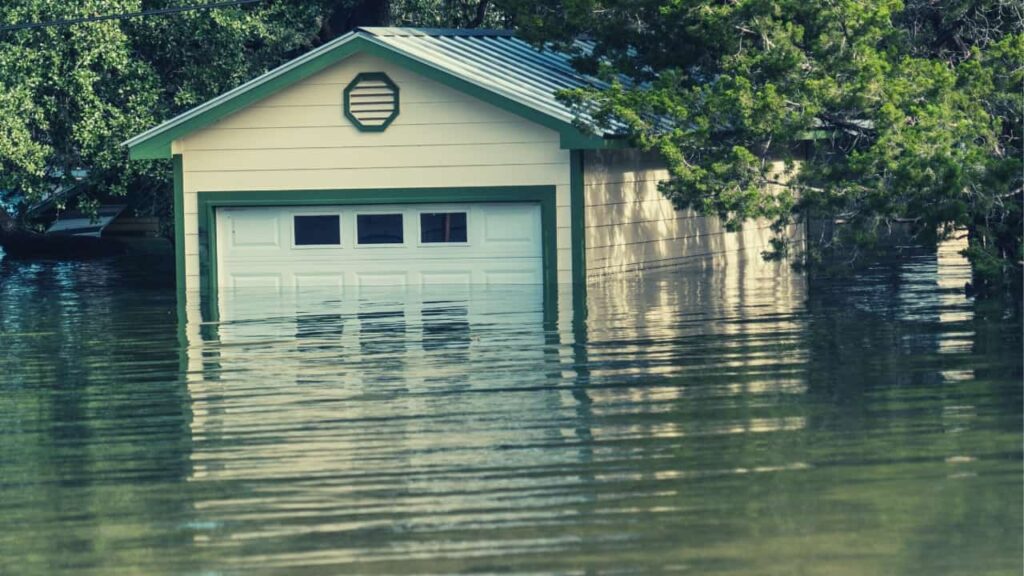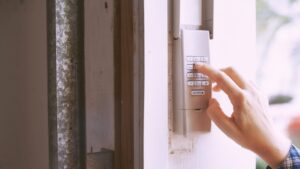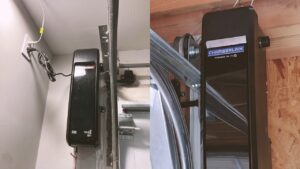If you’ve noticed water seeping into your home through the bottom of your garage door, it’s time to act!
This can be devastating in terms of damage to your belongings, and it can be expensive to repair the wet area., Fortunately, you can take some simple steps to prevent water from coming in under your garage door.
In this detailed guide, we’ll discuss how to keep water out of garage and offer you practical tips for that process.
Ready to dive in? Let’s get started!
Why Is It Important to Prevent Water Run Under the Garage Doors?

Preventing water entry beneath your garage door is essential to preserve its proper operation and prevent potential property damage risks.
This is because excess water can cause damage to your possessions, structural cracks in the door itself, and even lead to health issues. Some potential garage door problems that can arise from a leaking door include mold and mildew growth, higher energy bills due to air loss, water damage, and more.
Investing in a water prevention system is one of the smartest choices you can make when it comes to keeping your garage door safe, sound, and secure.
Common Reasons Why Water Seeps into Your Garage
Before trying to solve the water issue inside your garage, why not try to understand the root of the problem? So, the following are some common reasons why water may seep into your garage.
Poor Gutter System
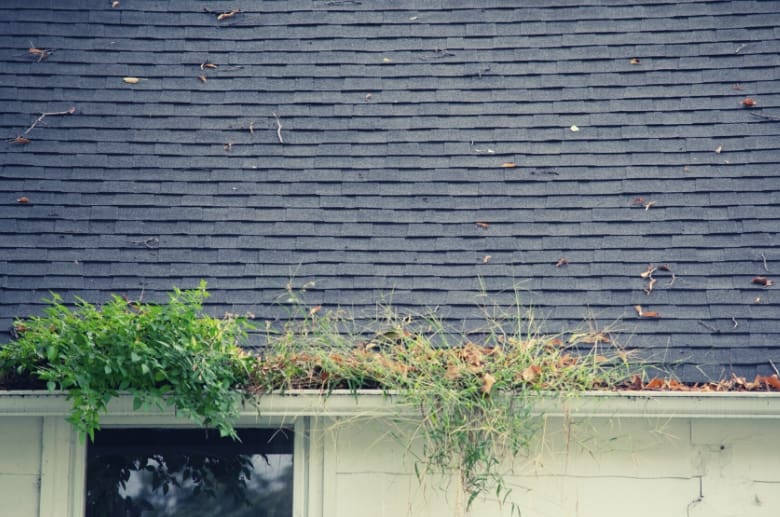
The gutter system in your home directs rainwater from your roof to the ground, and water can seep into the garage when your gutter system malfunctions due to obstructions or wear and tear.
Therefore, checking your gutter system at least twice a year is essential to determine its efficacy.
Also, ensure the grade around your house slopes away from its foundation, which will direct any rainwater or snowmelt out of reach, thus averting leakage into the walls and flooring of your garage.
Absence of a Drain
Your home or garage can’t survive without a drain. A garage drain helps keep the space dry by allowing water or other liquids to flow out of the garage into a specific location. This can help prevent water damage and minimize health hazards from spilled liquids from stagnant moisture.
Therefore, installing a basement waterproofing system with a sump pump is one of the best ways to prevent water from entering the garage.
This system pumps out any collected water and directs it away from your home’s foundation. French drains are also incredibly effective at waterproofing a garage because they collect groundwater and run it outside your house.
As a result, french drains prevent the water in your garage from infiltrating the garage walls and floors.
Missing or Damaged Garage Door Vinyl Trim
Another common cause of water entering a garage is a missing or damaged garage door vinyl trim.
The vinyl trim on the side and top of the garage door helps to create a seal between the door and the garage frame, preventing water from seeping in. Over time the vinyl trim can become worn or torn, allowing water to enter.
If this is the case, replacing the vinyl trim as soon as possible is essential.
A replacement vinyl trim can be purchased at most hardware or home improvement stores and is relatively easy to install.
The Garage Door Has No Weather Seals
Here’s a fascinating fact, the garage door is your main line of defence against water intrusion. That’s right. So, if your door doesn’t have proper seals, it becomes easy for rainwater and snowmelt to access your garage.
There’s a solution, though. Ensure you regularly inspect the weatherstripping on your garage door and replace it if worn out or damaged.
Installing a threshold seal at the base of your garage door is also a great way to keep water out of the garage. This rubber strip acts like a mini-dam, preventing water from entering once you close the garage door.
Connect With A Garage Expert
Connect with local experts, Compare quotes, Get the best price.
Landscaping Problems
Everyone loves their lawn, front, or backyard looking nice after landscaping. But there’s a correct way to do it, and any mistakes can lead to water damage.
If the landscaping near your garage isn’t correctly designed, it can cause water to pool up against the walls and floor. Therefore, ensure your lawn slopes away from the foundation of your house to prevent any water from stagnating.
This will help prevent water from seeping into your home or garage. Additionally, inspect cracks or crevices in the walls and floors of your garage regularly. If you find cracks or gaps in your garage walls, seal them immediately to prevent further water intrusion.
Melting Snow
Although most people only have to worry about this issue during certain months, those in Canada and the northern US may experience it for much longer. Fortunately, there are several ways to address snow melt.
If you have a bigger budget, installing drains in your garage can be helpful. It’s essential to ensure the floor is sloped towards the drain to drain any melted snow quickly.
On the other hand, for those with a more limited budget, Installing heaters can be a cost-effective option to evaporate snowmelt that would usually escape through vents.
However, it’s important to note that extended use of these heaters could increase electricity expenses.
Humidity
High humidity levels in your garage can also lead to more water entering your garage. If your garage is in an area with high humidity, this can lead to condensation on the walls and floors, which can cause water buildup and seep through cracks or crevices.
To safeguard your garage from this, install a dehumidifier and keep it running throughout the year. This can help reduce the air’s moisture and ensure condensation does not form on the walls and floor.
Joint Seams
Have you ever seen the small gaps between two concrete slabs in your garage? These are known as joint seams and should not have cracks or crevices.
To prevent this, you should regularly inspect all the joint seams around your garage and seal any cracks or crevices you find. You can find the joint seams in the walls and floors of your garage and around the door frame.
Sloped Driveway
If your driveway slopes down toward your garage rather than away, this can lead to rainwater finding its way onto the garage floor.
The solution here is to consider trench drains. Regular maintenance is also necessary for these trench drains because they are a great way to ensure the waterproofing of your garage door.
Position the drains in front of your garage doors to manage any collected rainwater and ensure it flows away
5 Steps on How to Keep Water Out of Garage
So, we’ve covered the common reasons why your garage may experience an overwhelming amount of water. We know it can be frustrating and expensive to cope with. But we promised to assist you accordingly, and we’ll deliver on that promise!
So, here are the steps to keep water out of the garage and protect your property.
Step 1: Replace Old Gutters or Add Awnings
Of course, you must first check the gutters around your house and ensure they are debris-free.
If your gutter system has served its purpose to the fullest or is damaged, replace it with a new system immediately. You can also add awnings over windows and doors to direct water away from the garage.
Step 2: Add Door and Floor Seals
The next step is adequately sealing the threshold and door frames to prevent water infiltration.
If you find any gaps in the seal, rest assured that water will find a way into your garage, That means you must eliminate gaps or cracks on your garage door or the floor. You can buy vinyl stop molding that sticks to the edges of the frame and create a barrier that will keep water out.
Also, check for any cracks in the foundation walls around your garage, as this can cause flooding during heavy downpours. Ensure you seal all these areas with an appropriate sealant so no water can enter them.
Step 3: Unclog French Drains (Or Add One)
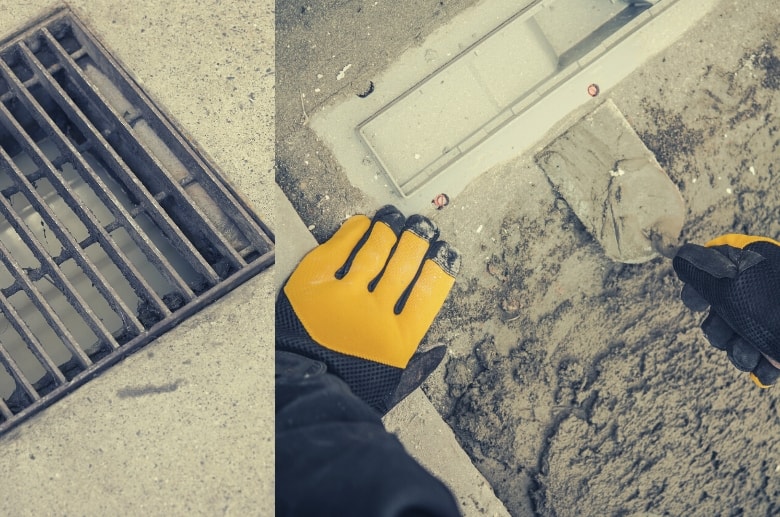
If you have a French drain outside your garage, ensure it’s not clogged with debris. If it is, get rid of the blockage as soon as possible.
Alternatively, if you still need to put one in place, consider installing a French drain to divert water away from the house and into an area where it will be less likely to cause damage.
A French drain costs $30 – $100 per linear foot. To find the linear footage for your basement, add the length of each wall. For example, a 36′ by 24′ foot basement would be 120 linear feet (36′ +24′) + (36’+24′).
Step 4: Cover Windows and Vents
Securely cover all the windows and vents of your garage to prevent rainwater from entering the garage through them.
You can use plastic sheeting or special window covers for this purpose. Lastly, close any vents that lead air into your garage if you’re not using them now.
Step 5: Install a Sump Pump
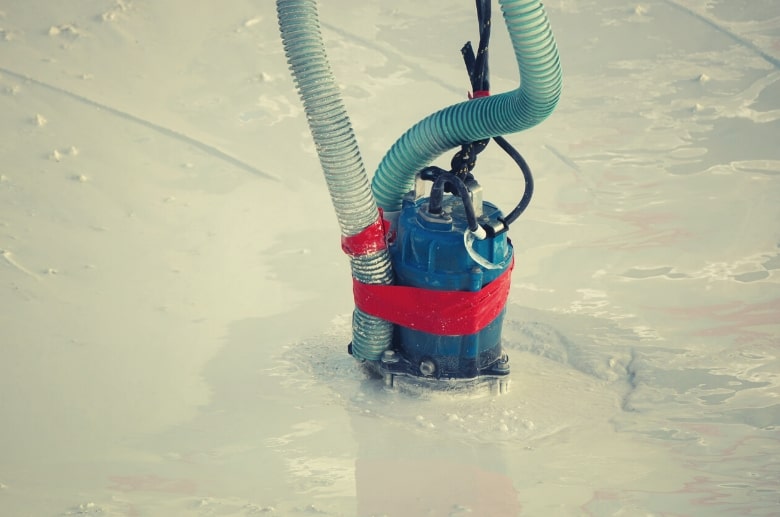
A sump pump is a device used to evacuate water accumulated in a sump basin, usually found in the basement of a house. A sump pump is a great way to quickly remove any water collected in the lowest parts of your garage.
Ensure you get a powerful pump to handle the amount of water you expect to deal with. Also, check the sump pump every three to four months and replace it if necessary.
Step 6: Fix Leaks in Garage Doors
To fix leaks, you first need to determine the source of the leak. If the leak comes in through a door crack, use a silicone sealant or caulk to fill it in. If there’s a gap between your garage door and the wall, you can use weatherstripping or foam insulation to create a better seal.
If there are any gaps between your garage door and its tracks, use sealant or caulking to close them off, and this will prevent water from entering your garage through these cracks and crevices.
Step 7: Examine the Driveway’s Borders
To examine the driveway’s borders, look for any signs of water damage or cracks. Check around the perimeter of the driveway, along the edge, and near your garage door. If you find any cracks, fill them with sealing caulk or silicone.
You can also inspect the bottom panel of your garage door to determine if any cracks allow water to enter. If there are gaps, use a silicone sealant to close them off and prevent water from entering your garage.
Use tools like a flashlight or a mirror to check the underside of your garage door and its tracks. You may also need to adjust the weather stripping at the bottom of your garage door if it’s not sealing properly.
Over time, the weather stripping can become worn down and no longer provide an effective seal against water.
Connect With A Garage Expert
Connect with local experts, Compare quotes, Get the best price.
Should You Hire a Professional to Weatherproof Your Garage?
While weatherproofing your garage may seem like a good and cost-effective idea, it’s not! We’re sorry to burst your bubble. It’s best to leave that job to the professionals.
Hiring a professional ensures you prepare your garage for severe weather events and can save you from costly repairs.
Professional contractors are experienced in evaluating and applying necessary materials or services to ensure your garage can withstand whatever nature throws.
Most people spend about $4,500 to insulate the walls and ceiling of a two-car garage with batts and blown-in insulation. The national cost range for this project is typically between $2,000 and $6,000.
Professionals recommend budgeting about $4-$7 per square foot for materials and services. But this will depend on the size of your garage since the cost could vary widely.
Ultimately, doing it right with an experienced contractor can provide peace of mind knowing that your family and valuables are safe during storms or other unexpected weather changes.
When considering the products, you can expect to pay up to $50 per linear foot for sealants and plastic drain kits. The labor cost for this job is around $300-$4,000, depending on the complexity of the project and the amount of drainage required.
In short, it’s better to be safe than sorry when protecting your valuable investments from water damage.
Final Verdict
Minor leaks in the garage often go unnoticed since it is an area of the home which remains out of sight for many homeowners. However, not addressing these leaks can cause serious issues like water damage later on.
Water damage can erode walls, ruin insulation and foundation, cause mold and mildew growth, and create hazardous conditions like pooling water.
Hence, fixing leaks as soon as possible is crucial to keep your garage dry and prevent further damage. A proactive approach can save money on costly repair bills and helps create a safer environment.

